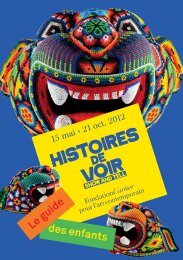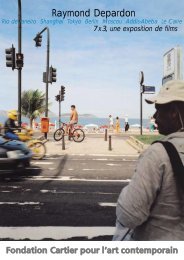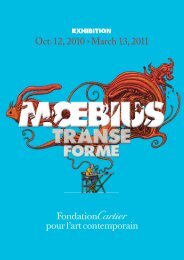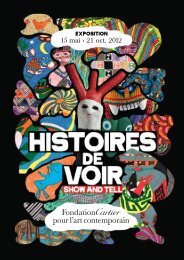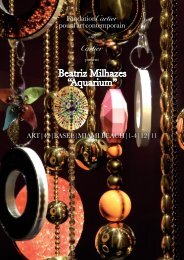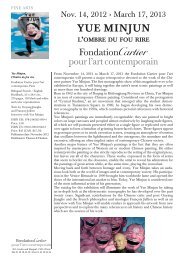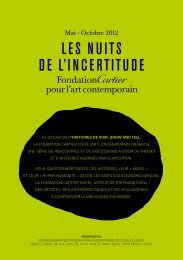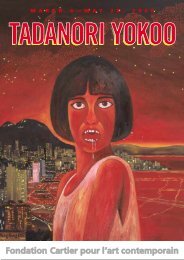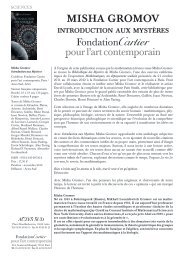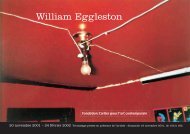March 11 ? Sept. 12, 2010 - Fondation Cartier pour l'art ...
March 11 ? Sept. 12, 2010 - Fondation Cartier pour l'art ...
March 11 ? Sept. 12, 2010 - Fondation Cartier pour l'art ...
Create successful ePaper yourself
Turn your PDF publications into a flip-book with our unique Google optimized e-Paper software.
INTERVIEW REAlIZED BY MICHEl TEMMAN (EXCERPTS FROM THE CATAlOG)<br />
INTERVIEW WITH<br />
BEAT TAKESHI KITANO<br />
—<br />
miChel temmAn Your exhibition at the <strong>Fondation</strong> <strong>Cartier</strong><br />
is a new chapter in your already prolific career. Is it like<br />
a dream come true?<br />
beAt tAkeShi kitAno I feel like a mountain climber who has<br />
been asked to climb Mt. Everest without a supply of oxygen.<br />
When the <strong>Fondation</strong> <strong>Cartier</strong> asked me to do this exhibition, it<br />
might have been the lack of oxygen that led me to say: “Okay,<br />
I’ll do it.” Anyway, I think I was somewhat dehydrated. After<br />
things had gotten off the ground, when it became hard to say,<br />
“In fact, I’m not really sure of myself anymore,” I got worried.<br />
We had gone past the point of no return, and I wanted to say<br />
to the <strong>Fondation</strong> <strong>Cartier</strong>: “Wait a second! Are we actually<br />
going to do this exhibition?” […]<br />
miChel temmAn When you were working on the<br />
exhibition, what were your priorities and what was your<br />
greatest desire? What was going on in your head?<br />
beAt tAkeShi kitAno I like the painting and the work of<br />
Renaissance painters like leonardo da Vinci. What I admire<br />
about them is that, throughout their lives, they didn’t confine<br />
themselves to one path or define themselves by a single interest.<br />
Da Vinci was a painter, but he was also a scientist. I like<br />
the idea that he was able to combine elements from different<br />
fields and that this combination made up his artistic oeuvre.<br />
He was constantly doing new things with his hands. I like that<br />
approach, that characteristic of the Renaissance artists: their<br />
versatility. Nowadays, however, it has become terribly common<br />
to segregate all of these different fields. We think we have to<br />
separate each discipline and clearly distinguish artists from<br />
scientists. Specialization is something that is becoming more<br />
and more apparent in our times. However, for the education<br />
of our children—and this is, in fact, true not only for children,<br />
but for everyone—it is much more stimulating and exciting<br />
to jam everything together in one pot. And, of course, being<br />
a comedian, I can’t help but incorporate silliness and mockery<br />
into the installations and paintings in this exhibition. But<br />
who knows what will happen? Someone, a child perhaps, will<br />
be astonished by a certain installation and want to become<br />
a scientist. Another kid might want to become an artist, and<br />
another, a comedian. […]<br />
miChel temmAn The Director of the <strong>Fondation</strong> <strong>Cartier</strong><br />
Hervé Chandès chose the title Gosse de peintre<br />
(“the painter’s kid”) for the exhibition. This was the<br />
nickname you were given in school by other children<br />
who made fun of your father’s job…<br />
beAt tAkeShi kitAno Yes, it’s true, and in fact the title conveys<br />
the message I wanted to express. Other kids often mocked<br />
me because I was the son of a house painter. That happened<br />
a lot when I was in primary school, junior high and even high<br />
school. They would say: “Oh, you’re the house painter’s kid!”<br />
I heard it all the time. That’s partly why I drew away from the<br />
5<br />
other kids when I was in school. I don’t know how things are in<br />
Europe, but in Japan house painters are ridiculed because you<br />
see them wearing their used coveralls stained with paint, and as<br />
a result, their dirty clothes make them a target of derision. So in<br />
school, I kept my distance from the bullying and the teasing of<br />
my classmates, and in fact I liked being on the outside looking<br />
in. I was like a spectator observing them objectively, it seemed<br />
to me, from the outside. And I think this helped me later on,<br />
especially when I was starting out as a stand-up comic. Watching<br />
people, knowing how to observe them, is the most valuable skill<br />
a comedian can have. I had learned how to observe the kids who<br />
made fun of me, their behavior and ways of thinking, and that<br />
habit later became very useful, it became an asset for me.[…]<br />
miChel temmAn It [the exhibition] reveals you, for<br />
the first time, as a visual artist. And it includes so many<br />
different forms of artistic expression: it could have been<br />
called Takeshi’s Vertigo. After Beat Takeshi, the TV star, and<br />
Kitano, the filmmaker, is this the birth of a new Takeshi?<br />
beAt tAkeShi kitAno Well, when I work on a television program<br />
or on a feature film, there are always certain limits. For<br />
example, with TV shows there are restrictions in terms of<br />
content. The producers and directors, of course, tell me I can<br />
do anything I want. But in reality, when you’re working with a<br />
commercial network, you have to take the sponsors into consideration,<br />
which means that you can’t criticize them on the<br />
show. This is also applicable to movies, and the film industry<br />
has its own constraints. For this exhibition, on the other hand,<br />
I was given free rein. There were no restrictions—outside of<br />
the physical limitations, of course—and that was quite new<br />
for me. It was probably the most “anything goes” situation I’ve<br />
ever experienced, and I took it as far as I wanted to go.<br />
—<br />
PubliCAtion<br />
Beat Takeshi Kitano, Gosse de peintre<br />
Opening the door to Kitano’s<br />
world, this catalogue offers<br />
a behind-the-scenes look at the<br />
exhibition. Drawings of objects,<br />
blueprints of the installations<br />
and paintings by the artist wind<br />
back to the genesis of an<br />
extraordinary project. Through<br />
a rich iconography drawn<br />
from his films and top TV shows,<br />
the reader retraces in images<br />
Kitano’s exceptional career.<br />
limited edition of 150 box sets,<br />
containing a book signed by<br />
the artist and a litograph. Price<br />
available on demand. Exclusively<br />
sold at the <strong>Fondation</strong> <strong>Cartier</strong><br />
<strong>pour</strong> l’art contemporain Bookshop<br />
and on fondation.cartier.com<br />
<strong>Fondation</strong> <strong>Cartier</strong> <strong>pour</strong> l’art<br />
contemporain, Paris /<br />
Actes Sud, Arles<br />
Softback, 24 × 30 cm, 264 pages,<br />
200 color illustrations, 43 €




